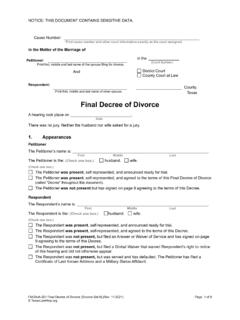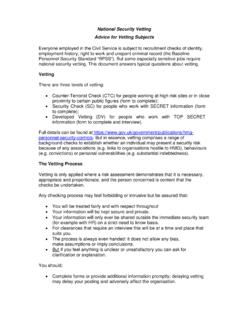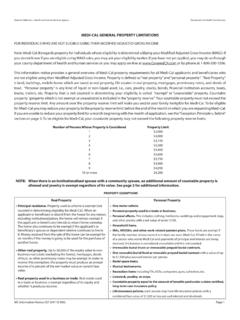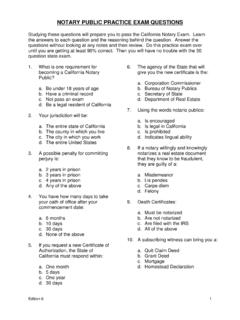Transcription of Texas Transfer Toolkit Pass it On. - TexasLawHelp.org
1 Texas Transfer Toolkit Plan Ahead. Pass it On. Texas Transfer Toolkit Overview The Texas Transfer Toolkit is a digital resource from the Texas Access to Justice Commission (TAJC) to help Texans with limited means Transfer their home, car or money in a bank account to a beneficiary upon their death. When someone dies without designating a beneficiary to receive these items, their loved ones must go to probate court and have a judge to decide who gets them a process that can be costly, stressful and time-consuming. Although someone can designate who will get these items in a will, a will still must go through the probate process. Hiring a lawyer to navigate this process may be an unnecessary expense for those without complex estates. If an individual only wishes to Transfer a home, car or money in a bank account, this Toolkit can avoid probate and save money. What's Included The Toolkit contains several forms to be completed by an asset owner prior to death, as well as one form to be completed by the beneficiary after the owner's death.
2 The forms included in the Toolkit are: Transfer on Death Deed and Affidavit of Death, which Transfer title to a home Beneficiary Designation for a Motor Vehicle and Application for Texas Title and/or Registration forms to Transfer title of a vehicle Instructions to complete or cancel the paperwork and how to obtain a Payable on Death account from their bank are also in- cluded. Preparing these forms prior to a crisis can save time, money and stress for those who are grieving. Why It's Important Although these forms previously existed, the new Toolkit gathers them in one centralized place, eliminating an obstacle that may have prevented individuals from taking these steps. By providing this resource for free, TAJC hopes to empower people to plan ahead and take care of their family. Who Should Use It This new resource is primarily for people with very limited assets and not for those with more complex estate issues.
3 However, anyone can use the Toolkit forms to Transfer their car, home or money in a bank account, even if they also need a will to trans- fer additional assets, such as jewelry or stocks. Individuals with more assets should consult a lawyer to ensure their wishes are followed. Where to Find It In addition to providing the Toolkit online at , free legal aid clinics across the state will increase awareness about these forms. Transfer on Death Deed Instructions Important Notice to Property Owner Carefully read all instructions for this form. It is best to talk to a lawyer before using this form. For privacy and identity theft reasons, you should not put your social security number or driver's license number on this form. What Is a Transfer on Death Deed? A Transfer on death deed is a simple, inexpensive way to Transfer real estate to someone else upon your death. It does not involve going through probate court, which can be a lengthy and costly process.
4 It works similarly to a life insurance policy or a payable on death account at a bank because the asset passes to your named beneficiary upon your death outside the probate system. When to Use a Transfer on Death Deed You may want to use a Transfer on death deed when you own real property, such as a house or land, and you want to give that property to someone else when you die. Things to know About Using a Transfer on Death Deed A Transfer on death deed does not affect any of your property rights during your lifetime. It only takes effect after your death. You can sell the property, use it as collateral on a loan, get property tax exemptions, and enjoy all the other prop- erty rights you currently have. The named beneficiary has no legal right to the property until your death. If you decide to sell the property, the named beneficiary cannot stop you from doing so. The sale simply voids the Transfer on death deed and it is as if the Transfer on death deed never existed.
5 You can only give someone the portion of the property that you own. For example, if you and your spouse own the property in equal shares and you file a Transfer on death deed giving the property to someone, like a child or a friend, that person only gets your share of the property. Your spouse still has their share. A Transfer on death deed trumps a will. If you have a will that gives the property to someone else, this Transfer on death deed trumps the will. The benefi- ciary named in the Transfer on death deed gets the property, not the person named in your will. If you already have a will, it is best to talk to an attorney about the pros and cons of using a Transfer on death deed. If you make a will at some point in the future that gives the property to a different person than the beneficiary listed in this Transfer on death deed, that provision does not override the deed. The beneficiary named in this Transfer on death deed still gets the property.
6 If you change your mind about who you want to get the property, you need to complete the cancellation of Transfer on death deed or file an updated Transfer on death deed. A Transfer on death deed does not protect the property from creditor claims. You may use a Transfer on death deed even if there is a debt or lien, such as a mortgage, against the property. However, upon your death, your beneficiary takes the property subject to all mortgages, liens and claims and will be responsible for paying those debts on the property. Also, if the property owner dies and has other unpaid debts, the property could be tied up in probate court until those debts are resolved. Texas Transfer Toolkit | Transfer on Death Deed 1. The Transfer on death deed beneficiary must survive you by at least 120 hours. If not, the property is treated as if the Transfer on death deed did not exist. A Transfer on death deed cannot be created by a person acting under a property owner's power of attorney, however, that person can cancel the Transfer on death deed.
7 Required Must Sign in Front of a Notary: Do not sign or date the Transfer on death deed until you are standing in front of a notary public. Must Record Transfer on Death Deed Before Your Death: You must record (file) this deed before your death with the county clerk where the property is located or it will not be effective. 1. Property Owner (Transferor) Making this Deed: Enter your first, middle (if any), and last name, along with your mailing address. Write your name exactly as it appears on the deed you received when you became an owner of the property. If you now go by a different name, write your name as listed on the deed, followed by AKA (also known as) and your current name. If more than one person owns the property, each person must do this. 2. Legal Description of the Property: Enter the legal description of the property, which is different from the mailing or physical address of the property.
8 This information is on the deed you received when you became an owner of the property and is also available at the county clerk's office in the county where the property is located. Do NOT use the legal description listed on your property tax bill because it is usually incomplete. IT IS VERY IMPORTANT THAT THIS INFORMATION IS CORRECT. If you are not absolutely sure, talk to a lawyer. 3. Address of the Property: Enter the physical address of the property. 4. Primary and Alternate Beneficiaries: You must check the box for A, B, or C. Check ONLY ONE box and fill in the blanks in that section. Fill out Selection A if you are married and you and your spouse own the property together. Fill out Selection B if you are married and you own all or part of the property by yourself (your spouse doesn't own any part of it) AND you want your spouse to get your share of the property. Fill out Selection C if either you are not married OR if you are married and do not want your share of the property to go to your spouse.
9 Each selection (A, B, or C) has three parts: 1. Primary Beneficiary: A beneficiary is the person who will own the property when you die. The primary beneficiary is the first person you want to own the property. You can, but are not required to, name more than one person as primary beneficiary. 2. Alternate Beneficiary or Beneficiaries: The alternate beneficiary or beneficiaries are the people you want to own the property if the primary beneficiary or beneficiaries die before you do. 3. Transfer on Death: This section tells how you want your property to pass if all your beneficiaries die before you. For Selection A and B: Initial option (a) if you want the alternate beneficiary or beneficiaries' living children, grandchildren, or great-grandchildren to get your share of the property if that beneficiary dies before you do. Initial option (b) if you DO NOT want the alternate beneficiary or beneficiaries' children, grandchildren, or great-grandchildren to get your share of the property if that beneficiary dies before you do.
10 For Selection C, section: A. If at Least One Primary Beneficiary Survives Me: If you name more than one primary beneficiary, this section tells what you want to do with your share of the property if one or more primary beneficiaries die before you, but one or more are still living. Texas Transfer Toolkit | Transfer on Death Deed 2. Initial option (a) if you want the deceased primary beneficiary or beneficiaries' share to go to that person's living children, grandchildren, or great-grandchildren. Initial option (b) if you DO NOT want the deceased primary beneficiary or beneficiaries' share to go to that person's children, grandchildren, or great-grandchildren. This share will be split among the living primary beneficiaries. B. If NO Primary Beneficiary Survives Me (dies after I do): If my primary beneficiary is my child (or other descendant) or my brother or sister (or other descendant of either of my parents) AND all primary benefi- ciaries die before I do, I grant and convey (give) my share to (choose by writing your initials in ONE blank ONLY): Initial option (a) if you want the deceased primary beneficiary or beneficiaries' share to go to that person's living children, grandchildren, or great-grandchildren.







![Defendant’s Answer [Civil Case, not Family]](/cache/preview/d/e/0/8/9/3/6/3/thumb-de08936371817b276b5f68d589c7149d.jpg)
![Notice of Nonsuit without Prejudice [Family Case]](/cache/preview/9/d/0/3/7/f/8/7/thumb-9d037f87decd7a0d7743fee71f3fb263.jpg)




